Air toxics exposure from vehicle emissions at a U.S. border crossing: Buffalo Peace Bridge Study
- PMID: 21913504
- PMCID: PMC8941851
Air toxics exposure from vehicle emissions at a U.S. border crossing: Buffalo Peace Bridge Study
Abstract
The Peace Bridge in Buffalo, New York, which spans the Niagara River at the east end of Lake Erie, is one of the busiest U.S. border crossings. The Peace Bridge plaza on the U.S. side is a complex of roads, customs inspection areas, passport control areas, and duty-free shops. On average 5000 heavy-duty diesel trucks and 20,000 passenger cars traverse the border daily, making the plaza area a potential "hot spot" for emissions from mobile sources. In a series of winter and summer field campaigns, we measured air pollutants, including many compounds considered by the U.S. Environmental Protection Agency (EPA*) as mobile-source air toxics (MSATs), at three fixed sampling sites: on the shore of Lake Erie, approximately 500 m upwind (under predominant wind conditions) of the Peace Bridge plaza; immediately downwind of (adjacent to) the plaza; and 500 m farther downwind, into the community of west Buffalo. Pollutants sampled were particulate matter (PM) < or = 10 microm (PM10) and < or = 2.5 microm (PM2.5) in aerodynamic diameter, elemental carbon (EC), 28 elements, 25 volatile organic compounds (VOCs) including 3 carbonyls, 52 polycyclic aromatic hydrocarbons (PAHs), and 29 nitrogenated polycyclic aromatic hydrocarbons (NPAHs). Spatial patterns of counts of ultrafine particles (UFPs, particles < 0.1 microm in aerodynamic diameter) and of particle-bound PAH (pPAH) concentrations were assessed by mobile monitoring in the neighborhood adjacent to the Peace Bridge plaza using portable instruments and Global Positioning System (GPS) tracking. The study was designed to assess differences in upwind and downwind concentrations of MSATs, in areas near the Peace Bridge plaza on the U.S. side of the border. The Buffalo Peace Bridge Study featured good access to monitoring locations proximate to the plaza and in the community, which are downwind with the dominant winds from the direction of Lake Erie and southern Ontario. Samples from the lakeside Great Lakes Center (GLC), which is upwind of the plaza with dominant winds, were used to characterize contaminants in regional air masses. On-site meteorologic measurements and hourly truck and car counts were used to assess the role of traffic on UFP counts and pPAH concentrations. The array of parallel and perpendicular residential streets adjacent to the plaza provided a grid on which to plot the spatial patterns of UFP counts and pPAH concentrations to determine the extent to which traffic emissions from the Peace Bridge plaza might extend into the neighboring community. For lake-wind conditions (southwest to northwest) 12-hour integrated daytime samples showed clear evidence that vehicle-related emissions at the Peace Bridge plaza were responsible for elevated downwind concentrations of PM2.5, EC, and benzene, toluene, ethylbenzene, and xylenes (BTEX), as well as 1,3-butadiene and styrene. The chlorinated VOCs and aldehydes were not differentially higher at the downwind site. Several metals (aluminum, calcium, iron, copper, and antimony) were two times higher at the site adjacent to the plaza as they were at the upwind GLC site on lake-wind sampling days. Other metals (beryllium, sodium, magnesium, potassium, titanium, manganese, cobalt, strontium, tin, cesium, and lanthanum) showed significant increases downwind as well. Sulfur, arsenic, selenium, and a few other elements appeared to be markers for regional transport as their upwind and downwind concentrations were correlated, with ratios near unity. Using positive matrix factorization (PMF), we identified the sources for PAHs at the three fixed sampling sites as regional, diesel, general vehicle, and asphalt volatilization. Diesel exhaust at the Peace Bridge plaza accounted for approximately 30% of the PAHs. The NPAH sources were identified as nitrate (NO3) radical reactions, diesel, and mixed sources. Diesel exhaust at the Peace Bridge plaza accounted for 18% of the NPAHs. Further evidence for the impact of the Peace Bridge plaza on local air quality was found when the differences in 10-minute average UFP counts and pPAH concentrations were calculated between pairs of sites and displayed by wind direction. With winds from approximately 160 degrees through 220 degrees, UFP counts adjacent to the plaza were 10,000 to 20,000 particles/cm3 higher than those upwind of the plaza. A similar pattern was displayed for pPAH concentrations adjacent to the plaza, which were between 10 and 20 ng/m3 higher than those at the upwind GLC site. Regression models showed better correlation with traffic variables for pPAHs than for UFPs. For pPAHs, truck counts and car counts had significant positive correlations, with similar magnitudes for the effects of trucks and cars, despite lower truck counts. Examining all traffic variables, including traffic counts and counts divided by wind speed, the multivariate regression analysis had an adjusted coefficient of determination (R2) of 0.34 for pPAHs, with all terms significant at P < 0.002. Study staff members traversed established routes in the neighborhood while carrying instruments to record continuous UFP and pPAH values. They also carried a GPS, which was used to provide location-specific time-stamped data. Analyses using a geographic information system (GIS) demonstrated that emissions at the Peace Bridge plaza, at times, affected ambient air quality over several blocks (a few hundred meters). Under lake-wind conditions, overall spatial patterns in UFP and pPAH levels were similar for summer and winter and for morning and afternoon sampling sessions. The Buffalo Peace Bridge Study demonstrated that a concentration of motor vehicles resulted in elevated levels of mobile-source-related emissions downwind, to distances of 300 m to 600 m. The study provides a unique data set to assess interrelationships among MSATs and to ascertain the impact of heavy-duty diesel vehicles on air quality.
Figures









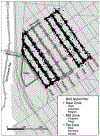











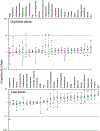

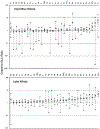

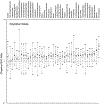
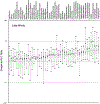




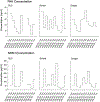
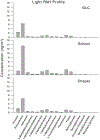

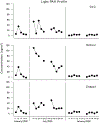

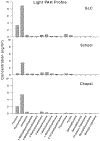


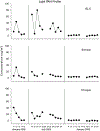


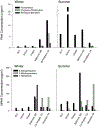





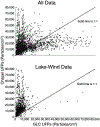
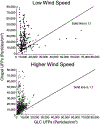


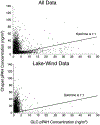
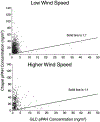



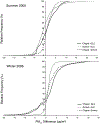
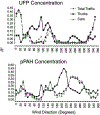




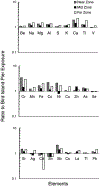
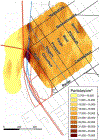
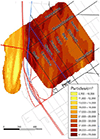
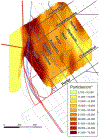
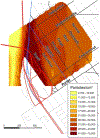
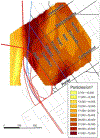
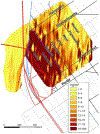
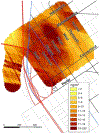
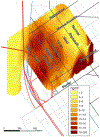
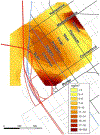
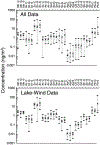
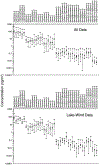
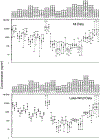

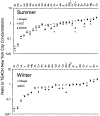



Similar articles
-
Potential air toxics hot spots in truck terminals and cabs.Res Rep Health Eff Inst. 2012 Dec;(172):5-82. Res Rep Health Eff Inst. 2012. PMID: 23409510 Free PMC article.
-
Personal and ambient exposures to air toxics in Camden, New Jersey.Res Rep Health Eff Inst. 2011 Aug;(160):3-127; discussion 129-51. Res Rep Health Eff Inst. 2011. PMID: 22097188
-
Characterizing Determinants of Near-Road Ambient Air Quality for an Urban Intersection and a Freeway Site.Res Rep Health Eff Inst. 2022 Sep;2022(207):1-73. Res Rep Health Eff Inst. 2022. PMID: 36314577 Free PMC article.
-
Assessment of long-term exposure to traffic-related air pollution: An exposure framework.J Expo Sci Environ Epidemiol. 2025 May;35(3):493-501. doi: 10.1038/s41370-024-00731-5. Epub 2024 Nov 16. J Expo Sci Environ Epidemiol. 2025. PMID: 39550493 Review.
-
TRP channels and traffic-related environmental pollution-induced pulmonary disease.Semin Immunopathol. 2016 May;38(3):331-8. doi: 10.1007/s00281-016-0554-4. Epub 2016 Feb 2. Semin Immunopathol. 2016. PMID: 26837756 Free PMC article. Review.
Cited by
-
Occupational exposure and respiratory health of workers at small scale industries.Saudi J Biol Sci. 2020 Mar;27(3):985-990. doi: 10.1016/j.sjbs.2020.01.019. Epub 2020 Jan 27. Saudi J Biol Sci. 2020. PMID: 32140043 Free PMC article.
-
Metallic elements and oxides and their relevance to Laurentian Great Lakes geochemistry.PeerJ. 2020 May 6;8:e9053. doi: 10.7717/peerj.9053. eCollection 2020. PeerJ. 2020. PMID: 32411527 Free PMC article.
-
Dopaminergic- and Serotonergic-Dependent Behaviors Are Altered by Lanthanide Series Metals in Caenorhabditis elegans.Toxics. 2024 Oct 17;12(10):754. doi: 10.3390/toxics12100754. Toxics. 2024. PMID: 39453174 Free PMC article.
-
Use of honeybees (Apis mellifera L.) as bioindicators for assessment and source appointment of metal pollution.Environ Sci Pollut Res Int. 2017 Nov;24(33):25828-25838. doi: 10.1007/s11356-017-0196-7. Epub 2017 Sep 21. Environ Sci Pollut Res Int. 2017. PMID: 28936680
References
-
- Abu-Allaban M, Gillies JA, Gertler AW, Clayton R, Proffitt D. 2003. Tailpipe, resuspended road dust, and brake-wear emission factors from on-road vehicles. Atmos Environ 37:5283–5293.
-
- Ahlbom J, Duns U. 1994. Nya hjulspår – en produkstudie av gummidäck. Rapport från kemikalienspektionen i samarbete med länsstyrelsen (Gothenburg).
-
- Antweiler RC, Taylor HE. 2008. Evaluation of statistical treatments of left-censored environmental data using coincident uncensored datasets. 1: Summary statistics. Environ Sci Technol 42:3732–3738. - PubMed
-
- Arey J. 1998. Atmospheric reactions of PAHs including formation of nitroarenes. In: Vol 3, The Handbook of Environmental Chemistry (Neilson AH, ed). Springer, Berlin, Germany.
-
- Arey J, Zielinska B, Atkinson R, Winer AM. 1987. Polycyclic aromatic hydrocarbon and nitroarene concentrations in ambient air during a wintertime high NOx episode in the Los Angeles basin. Atmos Environ 21:1437–1444.
Publication types
MeSH terms
Substances
Grants and funding
LinkOut - more resources
Full Text Sources
Medical
Research Materials
